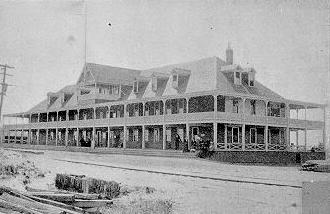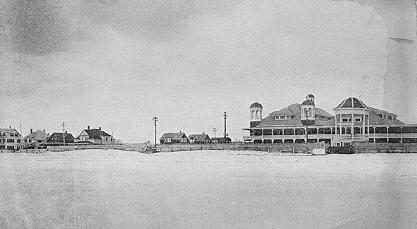By Carmelle (Caron) Druchniak
New Hampshire Sunday News
February 12, 1983
It was once touted as “the beautiful, big pride of New England beaches,” and so it remained for close to 50 years. Built along the Hampton Beach shoreline, this remarkable pleasure palace attracted tens of thousands of summer visitors each season; where else could one shoot some pool, bowl a few strings, watch a baseball game, take in a vaudeville revue, dine on succulent seafood, and dance the night away, all under one roof? A recreational complex that elevated having fun to an art, Hampton Beach Casino offered all these diversions and more.

Despite its reputation as a fun spot, the Casino’s original purpose was financial gain for the newly formed Exeter, Hampton and Amesbury Street Railway. In 1899, the company built the original Hampton Beach Casino on Ocean Boulevard, directly across from their trolley depot, in the hope that ridership to the beach would increase as a result.
Passengers from Amesbury, Newburyport, Exeter, and surrounding areas soon flocked to Hampton, in part because the trolleys offered a convenient and economical mode of travel. A trip from Market Square in Portsmouth to the beach, for example, cost 20 cents and covered the picturesque 14-mile distance in one hour and 15 minutes. The Casino itself proved a highly successful lure, however.
Illuminated by thousands of electric lights, the Casino celebrated its official grand opening Saturday, July 15, 1899. The two-and-a-half story building ran 190 feet along Ocean Boulevard and featured open porches running the entire length on both the ground and second levels.
Inside, the ground floor consisted of a dining room and a small cafe, both run by a “noted” Haverhill caterer. Most of the floor space, however, was taken up by several pool and billiard tables and two full-length bowling alleys.
Upstairs, a larger and more spacious dining room, complete with an open end fireplace made of seashells and stone, catered to the more sophisticated diner. Also on the second floor was a large hall suitable for dances, private gatherings, or road shows.
For the more fitness-minded, the casino had an athletic field in the rear, which doubled as a playground or baseball diamond. One hundred dressing rooms for swimmers and beachgoers were also added to the complex.
Because of the casino’s enormous popularity during its first year of operation, its owners began to work feverishly on two additions, both completed in 1900.
On the north end, a 57-room hotel, aptly named “Ocean House.” was built and connected to the original casino by a second story “bridge.” With 57 guest rooms, Ocean House featured such luxuries as electric lights and hot and cold running water in each room. An intricate electric bell system provided fast and efficient service to all rooms, day and night.
Note “bridge” connecting the two buildings.
The southern addition was nearly as large as the original building itself; the new two-and-a-half story convention hall had a frontage of only 47 feet, but ran 110 feet deep. The lower floor consisted of a billiard room and several more bowling alleys, while a large, auditorium-sized hall took up most of the second level.
It soon became evident that the two additions were not enough to contain the steadily increasing crowds. In 1901, construction was completed on the largest casino structure to date: the Opera House. On the south side of the convention hall, this building added 58 feet to the front of the complex and ran 120 feet deep. The original porches which ran along the casino were extended along the front of the new convention hall and newer Opera House, with the latter’s facade complimented by 2 hexogonal towers that were utilized as observatories.
The Opera House’s first floor featured 156 dressing rooms whose facilities were further expanded by the relocation of the casino’s original bath houses. The second floor was taken up by a 700-seat theater which featured vaudeville acts and the musical revues of the time. Also in 1901, a merry-go-round and a gun cottage were added to the rear of the casino.
With the casino finally expanded to fit the needs of its many visitors, business boomed and continued to do so for the next 20 years. In 1926, the last trolley of the Exeter, Hampton and Amesbury Street Railway made the trip to Hampton Beach, and service was discontinued. Ironically, the casino, which had been built merely as an attractive lure for trolley riders, remained in operation, drawing larger and larger crowds.
That same year, the Hampton Beach Casino Ballroom was built, and a new era in the casino’s history began. Incorporating part of the Opera House, plus added space toward the south, the ballroom was large enough to hold nearly 5,000 people on special nights and holidays, and its wooden dance floor was one of the largest in the region. The ballroom soon became the most popular nightspot in the area.
Its popularity reached its peak in the mid-1930’s big band era. Glenn Miller, Tommy Dorsey, and others, headlined the ballroom. Though liquor was prohibited and the dress code strict, thousands jammed onto the dance floor and danced beneath the large, mirrored ball.
By the end of World War II, however, the casino’s seemingly secure popularity began to decline and, during the next 25 years, steadily decreased. People seemed less inclined to travel to the casino, the idea beginning to seem somewhat dated. Newer forms of recreation, such as movies and television, were available. As a result, the casino soon began to suffer from neglect, both financially and structurally, the buildings becoming weathered and unsightly.
During the 1970’s, a much needed, long-awaited transformation began. The casino complex was taken over by a group of area businessmen determined to bring back the aging casino.
Between 1977 and 1982, more than one million dollars in renovations were completed, work which included rewiring the entire building, the demolition of Ocean House, and a partial revamping of the interior of the complex. The most obvious work done to date is the buildings’ new white-columned facade, completed in February 1982. These columns will suport a new second floor porch modeled after the original.
The former Hampton Beach Casino Ballroom, reopened in the mid-1970s as Club Casino, will also under go cosmetic and structural changes, while continuing to attract the younger crowd, as it has since its opening.
The Whale’s Tail Restaurant and Pub, a fairly new addition to the complex’s north end, has been redone and will encompass part of the second floor porch.
Inside the casino building, “mini-malls,” comprised of more than 40 different specialty shops, occupy most of the first and second story floor space, with indoor golf, arcades, video games, and kiddie rides occupying the remainder. The old Opera House theater has remained in operation, showing first-run films during the summer months.
With two or three more years of work planned, the present owners feel that the complex will again become the recreational center of Hampton Beach. Patronage has slowly increased during the last few years and its popularity seems to be rising steadily.
The question as to whether that popularity will ever reach that of the casino’s early years, remains to be answered, however. As the “pride of New England beaches,” the Hampton Beach Casino enjoyed a fame and prestige unparalleled by any other area resort. Through more than 40 years of hot summer days and long, balmy summer nights, it played host to hundreds of thousands who entered its doors with one simple purpose — to have fun.

